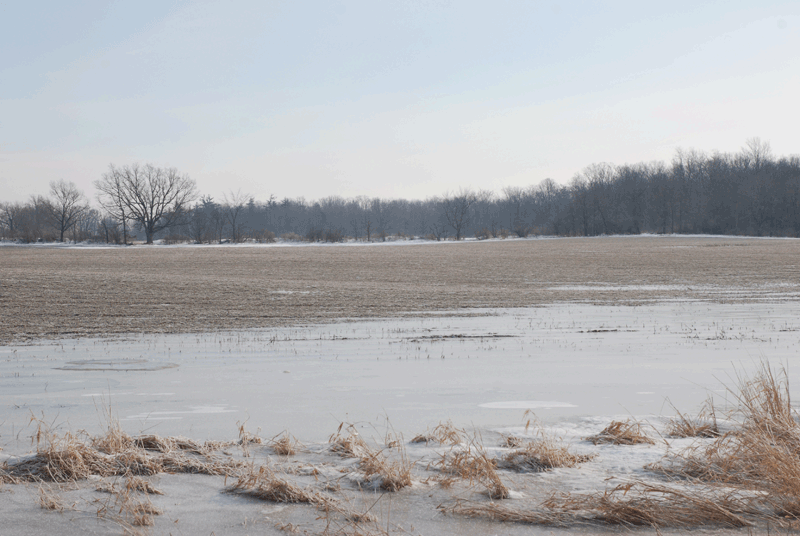How cold is too cold?
THE SURVIVAL OF WINTER WHEAT
COLD TEMPERATURES ACROSS the United States have left many American farmers wondering if their winter wheat crop will make it through the season. Estimates from early 2014 were already predicting a 15 to 20 percent loss in the Plains wheat belt, which encompasses Nebraska, Kansas, Oklahoma, northern Texas, and eastern Colorado.

But Ontario producers are less likely to see similar losses, says Peter Johnson, Ontario Ministry of Agriculture and Food and Ministry of Rural Affairs (OMAF and MRA) Cereals Specialist – Field Crops. In fact, Johnson says Ontario temperatures have only managed to kill wheat once in the past 100 years – and that was shortly after the Second World War.
“We’re not at the level of damage they’re predicting in Kansas,” Johnson says. “Ontario winter wheat is pretty cold-tolerant because snow cover makes a difference. It takes very little snow – even one to four inches – to provide amazing insulation.”
HOW LOW CAN IT GO?
Winter wheat’s survival in cold temperatures is dependent on two major factors: how low the temperature drops and the plant’s growth stage.
“As long as a plant has reached its winter hardy stage, Ontario winter wheat can withstand temperatures as low as about minus 21 at its crown, which is about an inch below the soil,” Johnson says.
Optimal winter hardy stage includes four leaves and two tillers. But plants at the spike stage would be no match for those temperatures, he warns.
Johnson suggests the vast majority of Ontario fields had enough snow through this winter to protect the crop, with possible exceptions in Niagara and Essex County where they saw less snow, high winds, and cold temperatures with minimal coverage.
THAW DOES MORE DAMAGE
Johnson says the greater concern to him is the temporary high temperatures that caused flooding on some fields. He says when water ponds in a field and then ices over again, winter wheat plants are in danger of suffocating.
“Even though it’s dormant, wheat needs to transpire, and it requires oxygen,” Johnson says. “It can’t access oxygen under ice or a depth of water.”
Johnson says if there is a layer of snow between a crop and ice, there is usually enough oxygen to keep it going. But when ice freezes tight to the ground, the producer needs to break the ice to let the water drain so plants can breathe.
THE WINTERKILL MYTH
“When wheat doesn’t make it, we call it ‘winterkill’ but it’s a misnomer,” Johnson says. “Most of the damage gets done in late fall and early spring.”
Johnson says in order to avoid cold injury, growers need to plant wheat in time for it to get to the optimal winter hardy stage by fall. He says in recent years soybean harvest has come first. He suggests growers need to try harder to get winter wheat in early if they want to avoid winterkill.
As for spring, Johnson says growers need to assess how many plants survived the winter. Fields with more than seven plants in a foot of a row can be left alone, but fewer than four in the same space is not good enough. If the surviving plants range from four to seven plants, producers need to assess the crop’s overall health.
“Of course, it’s never that uniform – that’s when they need to consider what percentage of the field has zero surviving plants, and what percentage has 18,” Johnson says. He adds aerial photos, such as those taken with unmanned aerial vehicles (UAVs), can be a big help in those situations because they give producers a good sense of the key factors, such as colour.
THE MAGIC BULLET
As a final measure, Johnson suggests nitrogen applications can bring questionable fields back to life. Nitrogen stimulates early plant growth, and can help marginal crops survive.
“If there’s any chance of saving a winter wheat crop, nitrogen will do it,” Johnson says. “Some growers don’t want to waste nitrogen on a field that’s not going to pull through, but I say put the nitrogen on, and if the wheat doesn’t make it, you have a field that’s ready to grow corn.”
He adds “maple syrup weather” – when the frost is out of the ground, and temperatures freeze at night and thaw by day – is the ideal time to apply the first nitrogen application of 50 to 90 pounds. He warns applying it too soon – when there is still snow on the ground or the soil is frozen – will only cause it to dissolve and blow away, leaving questionable winter wheat plants to make a slow and shaky comeback. •







